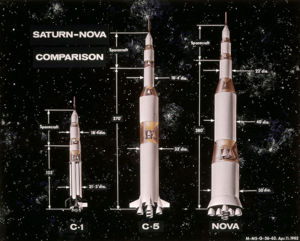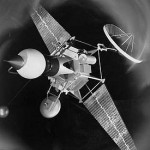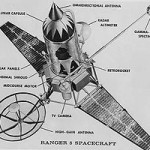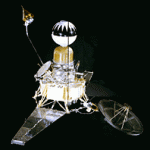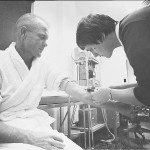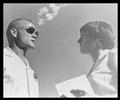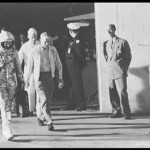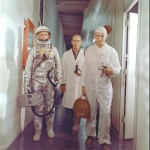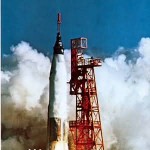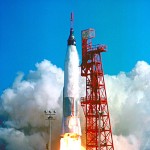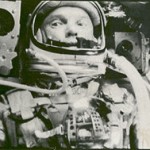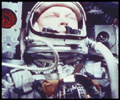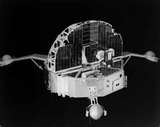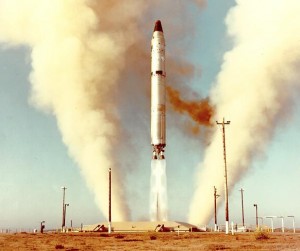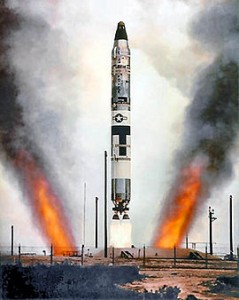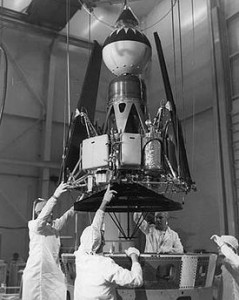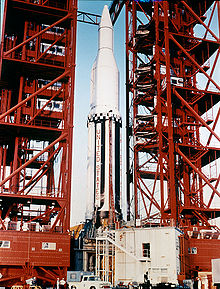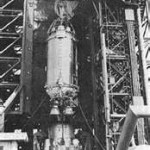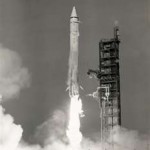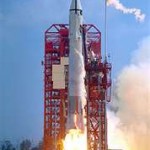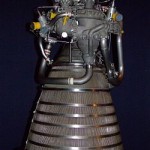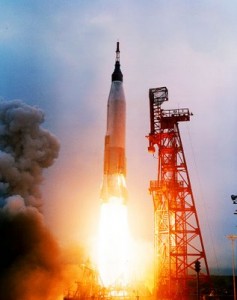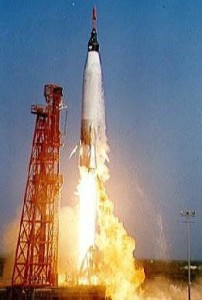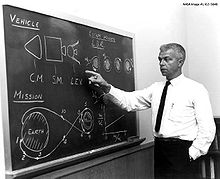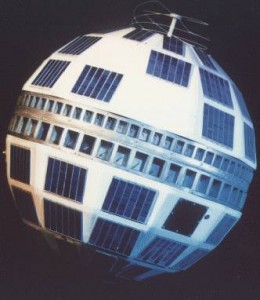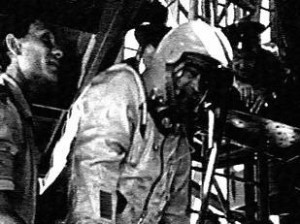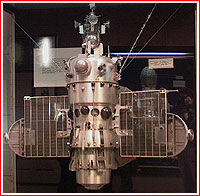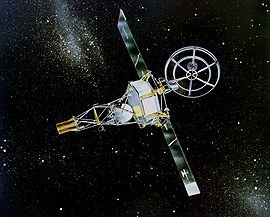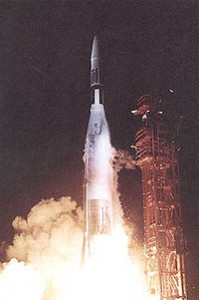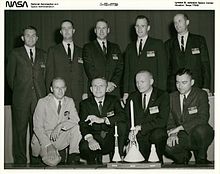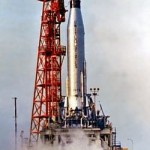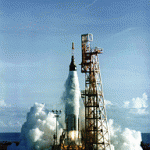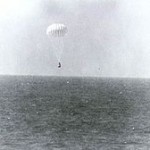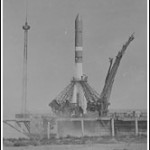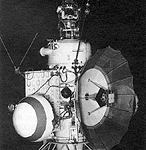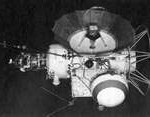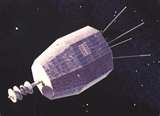 Orbital Launch Manifest 1962 (22.3 KiB)
Orbital Launch Manifest 1962 (22.3 KiB)
January: During 1961, the Saturn Project was in dynamic flux with several concepts being considered:
C-1 was now a two-stage vehicle.
C-1B was an interim vehicle to test advanced upper stages (S-IV).
C-2 was a launch vehicle proposed for Dyna-Soar.
C-5 was proposed as a launch vehicle for circumlunar or LOR landing with 5 F-1
rocket engines.
Nova was proposed for direct ascent lunar landing with 8-10 F-1 engines and a second
stage using an Aerojet proposed powerful M-1 engine using LH2/LO2.
 Nova (351.0 KiB)
Nova (351.0 KiB)
January 3: The Mercury Mark II program became Project Gemini.
January 5: NASA made public the drawings of the three-man Apollo spacecraft to be used in the lunar landing development program, On January 9, NASA announced its decision that the Saturn C-5 would be the lunar launch vehicle.
January 26: Launch of Ranger 3 by an Atlas Agena B from LC12 for a lunar impact mission. This was a Block II spacecraft (TV capability and a seismometer that would land intact on the surface) that missed the Moon by 22,862 miles and went into a heliocentric orbit. Interplanetary gamma ray flux was found to be 10 times greater than predicted/expected.
- Ranger 3
- Ranger Block II
- Ranger Block 2
February 20: Launch of Mercury-Atlas 6 with John H. Glenn, Jr. on a 3-orbit manned flight. John Glenn became the first American to orbit in his Friendship 7 Mercury spacecraft. Despite some problems with spacecraft—Glenn flew parts of the last two orbits manually because of an autopilot failure and left his normally jettisoned retrorocket pack attached to his capsule during reentry because of an indication of a loose heat shield—this flight was enormously successful.
- Glenn Dee OHara 1961
- Glenn Dee OHara 1962
- Glenn Douglas 022062
- Glenn Douglas Joe Schmitt 022062
- MA-6 Launch
- MA-6 Launch 2
- Glenn in flight
- Glenn in flight 2 022062
 MA-6 (Universal News) (14.6 MiB)
MA-6 (Universal News) (14.6 MiB)
 Mercury Atlas Launch 1962- John Glenn (14.3 MiB)
Mercury Atlas Launch 1962- John Glenn (14.3 MiB)
 NBC News Broadcast Coverage John Glenn 1962 Space Flight (24.1 MiB)
NBC News Broadcast Coverage John Glenn 1962 Space Flight (24.1 MiB)
 FIRBAL (364.0 KiB)
FIRBAL (364.0 KiB)
 GODSPD (644.0 KiB)
GODSPD (644.0 KiB)
March 7: Launch of the Orbital Solar Observatory (OSO-1) by a Thor Delta rocket from LC17A. The primary mission was to measure solar electromagnetic radiation in the UV, X-ray, and gamma-ray regions. Its secondary mission was to investigate dust particles in space.
March 12: A group of five civilian women with parachuting experience (Tatanya Kuznetsova, Valentina Ponomaryova, Irina Solovyova, Valentina Tereshkova, and Zhanna Yorkina) was added to the cosmonaut training program. Only Tereshkova would fly. A leading Soviet high-altitude parachutist, 20-year-old Tatyana Kuznetsova was, and remains, the youngest person ever selected to train for spaceflight.
March 15: A panel of cardiologists (Proctor Harvey, Thomas Mattingly, and Eugene Braunwald) was convened to evaluate the idiopathic atrial fibrillation of Deke Slayton and recommended disqualification from space flight.
March 16: First test launch of the Titan II from LC 16. First stage thrust was 430,000 lbs. Both stages burned Aerozine 50/Dinitrogen tetraoxide hypergolic fuels. 11 0f the first 22 test flights were failures. It was deployed from 1963-1987 with a peak of 63 missiles deployed in 1967.
March 30: The design configuration of the Gemini spacecraft was formally frozen.
April 9-12: Space Medicine Branch meeting in Atlantic City, New Jersey. Captain Frank B. Voris, MC, USN was elected President.
Space Medicine Panels:
Space Radiobiology
Space Medicine
Space Technology
Aerospace medicine and Project Mercury
Program 1962.pdf
 Abstracts 1962 (860.0 KiB)
Abstracts 1962 (860.0 KiB)
April 7: NASA announced that applications would be accepted for additional astronauts
until June 1, 1962. NASA planned to select five to ten astronauts to augment the seven-member Mercury astronaut team.
April 16: The development of the UR-500 (Proton) rocket booster was authorized in the Soviet Union.
April 23: Launch of Ranger 4 by an Atlas Agena B from LC12 for a lunar impact mission. This was a Block II spacecraft that impacted on the backside of the Moon, but a timer failed to deploy the solar panels and turn on the instrumentation.
April 25: Successful launch from LC34 of SA-2 (suborbital Block I Saturn 1 test flight of only the S-1 stage). 86,000 kg water released at apogee of 145 km in an upper atmosphere test. Engineers were pleased to find that the sloshing that had occurred on the first flight in the fuel tanks did not happen on SA-2. This they credited to the extra anti-slosh baffles that had been installed.
May 1: Manned Spacecraft Center’s Life Systems Division proposed to measure seven
parameters for determining crew condition during all Gemini flights. These were, in order of priority: blood pressure, with electrocardiogram and phonocardiogram serving as first and second backup; electroencephalogram; respiration; galvanic skin response, and body temperature. The bioinstrumentation required would cost about three and one-half pounds per man, with a total power consumption of about two watt-hours and the shared use of six channels of telemetry. Gemini Project Office reviewed these requirements and approved the following measurements: electrocardiogram, respiration rate and depth, oral temperature, blood pressure, phonocardiogram, and nuclear radiation dose.
May 8: Unsuccessful launch attempt of the Atlas Centaur 1. The rocket had been on the pad at LC 36A for over 15 months. There was a payload shroud failure resulting in explosion of the Centaur stage at 54 secs. This led to a Congressional investigation and the project being turned over to the NASA Lewis Research Center. The upper stage Centaur was developed by General Dynamics and was the first LO2/LH2 rocket giving it an Isp of 444 secs. It was developed as an upper stage for the Saturn Program (S-V stage) and had two Pratt Whitney RL-10 engines with 16,5000 lbs thrust each which were capable of multiple restarts.
 Atlas Centaur (172.0 KiB)
Atlas Centaur (172.0 KiB)
- Centaur
- Atlas Centaur Launch
- Atlas Centaur Launch 2
- RL-10
May 24: Launch of Mercury-Atlas7 with the spacecraft, Aurora-7, piloted by M. Scott Carpenter on a three-orbit flight. A glitch in the pitch attitude indicator required the astronaut to use manual control for the attitude. Excessive fuel usage occurred due to incorrect autopilot/manual attitude mode selection requiring the astronaut to convert to a free drift mode for 77-minutes. A late retro-rocket fire by three seconds and a 25-degree incorrect yaw angle on the manual attitude mode resulted in a 250-mile overshoot of the landing with a three-hour delay in recovery. Many of the problems were unrecognized hardware malfunctions and not pilot error, however, Carpenter never flew again.
 MA-7 (NASA) (12.4 MiB)
MA-7 (NASA) (12.4 MiB)
May 29: The Air Force School of Aviation Medicine, Brooks Air Force Base, Texas,
began a simulated long-duration Gemini mission. Two men were to live for 14 days in a 100-percent-oxygen atmosphere maintained at a pressure of 5 pounds per square inch, the proposed spacecraft environment.
June 7: At an all-day meeting at the Marshall Space Flight Center, NASA leaders met to hash out differences over the method of going to the Moon with Project Apollo, with the debate getting heated at times. The contention was essentially between Earth-orbit versus Lunar-orbit rendezvous (advocated by Langley Research Center engineer John Houbolt). After more than six hours of discussion those in favor of Earth-orbit rendezvous finally gave in to the lunar-orbit rendezvous mode, saying that its advocates had demonstrated adequately its feasibility and that any further contention would jeopardize the president’s timetable. This cleared the path for the development of the hardware necessary to accomplish the president’s goal. the Nova rocket concept was terminated.
July 8: A hydrogen thermonuclear bomb was detonated 200 miles over the Pacific after launch by a Thor rocket n Operation Dominic. Tests later showed that an artificial radiation belt was created by this explosion.
July 10: Launch of Telestar 1 (communications satellite) on a Thor Delta rocket from LC. Telstar 1 was the first privately sponsored (AT&T) space launch. A medium-altitude satellite, Telstar was placed in an elliptical orbit completed once every 2 hours and 37 minutes, inclined at an angle of approximately 45 degrees to the equator, with perigee about 1000 km from Earth and apogee about 6000 km from Earth, it is still in orbit. It relayed the first live TV transmission overseas on July 23.
JFK on Telstar (Universal News).mp4
 Telstar (Universal News) (7.4 MiB)
Telstar (Universal News) (7.4 MiB)
 Telstar Song (3.8 MiB)
Telstar Song (3.8 MiB)
July 22: Mariner-1 Venus flyby probe fails to reach orbit after launch by an Atlas Agena B from LC12. NASA-JPL-USAF Mariner R-1 Post-Flight Review Board determined that the omission of a hyphen in coded computer instructions transmitted incorrect guidance signals to Mariner spacecraft boosted by two-stage Atlas-Agena from Cape Canaveral on July 21. Omission of hyphen in data editing caused computer to swing automatically into a series of unnecessary course correction signals which threw spacecraft off course so that it had to be destroyed by the range safety officer.
August 11-15: 64-orbit flight of Vostok-3, piloted by Andrian Nikolayev. In 1961, Soviet rocket engineer Sergei Korolev pushed for a three-day spaceflight as a follow-up to Vostok 2. Such a mission was opposed by the head of cosmonaut training, Nikolai Kamanin and the cosmonauts themselves, who were concerned about unforeseen health effects that might result from extending space flights too quickly (Titov had severe space motion sickness on Vostok-2). Plans for a three-day mission only went forward when the approval of Soviet Premier Nikita Khrushchev was obtained; in the end, Vostok 3 would last nearly four days. Training was expanded to condition cosmonauts against space sickness and select those candidate spacefarers deemed least susceptible. The launch of Vostok 3 came over a year after the previous Soviet spaceflight, due in part to a Zenit rocket that exploded during an attempted high priority reconnaissance satellite launch, damaging on of the launch pads in May. Nikolayev unstrapped himself from his seat and became the first spacefarer to float freely in conditions of microgravity in space. He later married Valentina Tereshkova, and fathered the first child born to parents that had both flown in space.
Vostok 3 and 4 (Universal News).mp4
Vostok 3 and 4 (USSR).mp4
August 12-15: 48-orbit fight of Vostok-4, piloted by Pavel Popovich. Approached to within 6.5 km of Vostok -3. The Vostok spacecrafts did not have the ability to modify its orbit, so this was due to a pre-planned launch trajectory. Popovich had problems with his life support system, resulting in the cabin temperature dropping to 10 degrees Centigrade and the humidity to 35%. Before the mission, Popovich had been briefed to tell ground control that he was “observing thunderstorms” if he experienced the motion sickness that had plagued Titov and needed to return on the next opportunity. Unfortunately, he actually did report seeing thunderstorms over the Gulf of Mexico, and ground control took this as a request for an early return. He was ordered down a day early, landing within a few minutes of Nikolayev. Only on the ground was it discovered that he was willing to go the full duration.
August 17: Carl Sagan advocates the sterilization of all Lunar and Interplanetary spacecraft. He postulates that the Moon has probably already been contaminated by the Luna II and Ranger IV spacecraft. He also advocates for quarantining any returning spacecraft in the future.
August 25: A Venus lander (2MV-1 #3 also called Sputnik 19) was left stranded in the low Earth orbit as a result of the upper stage failure of the Molniya 8K78 rocket (a four staged modification of the R-7).
August 27: Successful launch of Mariner 2 by an Atlas Agena B from LC12.
 Mariner 2 (NASA) (2.9 MiB)
Mariner 2 (NASA) (2.9 MiB)
September 1: The 2MV-1 No. 4 Venus lander (also called Sputnik 20) was left stranded in the low-Earth orbit due to the fourth stage failure of the Molniya 8K78 rocket.
September 12: The 2MV-2 No. 1 Venus flyby probe (also called Sputnik 21) was left stranded in the low-Earth orbit due to the fourth stage failure of the Molniya 8K78 rocket.
September 17: A second group of nine astronauts (Neil Armstrong, Frank Borman, Charles Conrad, Jim McDivitt, Jim Lovell, Elliott See, Tom Stafford, Ed White and John Young) was selected by NASA in September 1962. All of this group flew missions in the Gemini program except Elliott See, who died in a flight accident while preparing for the Gemini 9 flight. All of the others also flew on Apollo, except for Ed White, who died in the Apollo 1 launchpad fire.
September 19: Albert Crews was added to the Dyna-Soar program and the names of the six active Dyna-Soar astronauts were announced to the public.
September 29: Launch of Alouette 1 (Canadian atmosphere research satellite) by a Thor- Agena B from Vandenburg AFB. First non-US/USSR satellite.
October 3: Launch of Mercury-Atlas 8 on a six-orbit mission with Sigma-7; piloted by Walter M. Schirra, Jr. It was termed a “textbook flight” with the only abnormality being minor increased thermal heating in the space suit. Fuel consumption was not a problem allowing confidence that longer Mercury flights could be scheduled. The increased radiation from Operation Dominic did not affect the flight as it was contained in a belt at an altitude of over 400-miles. MA-8 landed 275 miles northeast of Midway Island, 9,000 yards from the prime recovery ship, the USS Kearsarge. Schirra stated that he and the spacecraft could have continued for much longer. MA-8 launch was relayed via the Telstar satellite to television audiences in Western Europe.
- Launch MA-8
- MA-8 Liftoff
- MA-8 Landing
 MA-8 (NASA) (9.4 MiB)
MA-8 (NASA) (9.4 MiB)
October 15: French launch of a Veronique sounding rocket with a rat (Castor) on board. Reached an altitude of 75 miles.
October 18: French launch of a Veronique sounding rocket with a rat (Pollux) on board. Not recovered.
October 18: Launch of Ranger 5 by an Atlas Agena B from LC12, another Block II spacecraft in a lunar impact attempt. A malfunction led to the transfer of power from solar to battery power. Normal operation never resumed; battery power was depleted after 8 hours, and all spacecraft systems died. The first midcourse correction was never implemented, and Ranger 5 passed the Moon at a range of 724 kilometers on 21 October and entered a heliocentric orbit.
October 24: The 2MV-4 No. 3 (also called Mars 1962A or Sputnik 22) Mars flyby probe was left stranded in the low Earth orbit due to the fourth stage explosion of the Molniya 8K78 rocket.
October 25: B. F. Goodrich delivered a prototype partial-wear, quick-assembly, full-pressure suit to Manned Spacecraft Center (MSC) for evaluation by Life Systems Division. The partial-wear feature of this suit, demanded by the long-duration missions planned for the Gemini program, comprised detachable suit components (sleeves, legs, helmets). This was the second of two partial-wear suit prototypes called for by the original contract; but MSC had, in the meantime, requested B. F. Goodrich to provide 14 more suits based on this design. The additional suits varied only in size; they were to follow the design of the prototype according to the specifications of October 10, 1962. The prototype, originally designated G-2G, became G-2G-1 and the remaining suits were designated G-2G-2 through G-2G-15. MSC requested extensive design changes after
evaluating G-2G-1 and several other suits. The final model was G-2G-8, delivered to MSC on January 21, 1963. It was later rejected in favor of a suit designed by David Clark Company, Inc., Worcester, Massachusetts, which incorporated B. F. Goodrich helmets, gloves, and additional hardware.
November 1: The 8K78 Molniya rocket launches the Soviet Mars-1 probe (2MV-4 No. 4) toward Mars. Contact lost en route at the distance of 106 kilometers from Earth. Closest approach to Mars occurred at 193,000 km on 6/19/63. Also called Sputnik 23.
- Mars 1 Launch
- Mars-1
- Mars 1
November 1: Soviet Union high altitude balloon flight, “Volga”, was flown to test the Vostok capsule, pressure suit and ejection bail-out procedure. Maj. Yevgeny Andreyev bailed-out at 83,500 ft and Col. Pyotr Dolgov at 93,970 ft. Col. Dolgov died after his faceplate cracked after hitting the capsule during ejection and his suit depressurized. Col. Dolgov was possibly a designer of the ejection seat.
November 4: The 2MV-3 No. 1 Mars lander (also called Mars 1962B or Sputnik 24) left stranded in low Earth orbit due to the fourth stage failure of the Molniya 8K78 rocket.
November 7: NASA officially endorses LOR as the lunar landing mission profile.
November 16: Successful launch from LC34 of SA-3 (suborbital Block I Saturn 1 test flight of only the S-1 stage). 86,000 kg water released at apogee of 167 km in another upper atmosphere test.Third test flight.
December 13: Launch of Relay 1 from LC17A by a Thor Delta B.
December 13: Launch of a Project Stargazer balloon flight. Joseph Kittinger and William White reached an altitude of 81,500 feet.
December 14: The Mariner-2 spacecraft completes world’s first flyby of Venus at a distance of 34,800 kilometers and scanned its surface with infrared and microwave radiometers, capturing data that showed Venus’s surface to be about 425°C (800°F). Three weeks after the Venus flyby Mariner 2 went off the air on January 3, 1963. It is now in a solar orbit.
December 19: Titan II N-11, the eighth flight in a series conducted by the Air Force to develop the weapon system, was launched from Cape Canaveral. It carried a design change intended to reduce the amplitude of longitudinal oscillations which had appeared during first stage operation on all seven of the previous Titan II flights. This phenomenon, which subsequently became known as POGO, generated g-forces as high as nine-g in the first stage and over three-g at the position on the missile corresponding to the location of the spacecraft on the Gemini launch vehicle. Fearing the potentially adverse effect on astronaut performance of such superimposed g-forces, NASA established 0.25 g at 11 cycles per second as the maximum level tolerable for Gemini flights. As a first try at solving the POGO problem, Titan II N-11 carried standpipes in each leg of the stage I oxidizer feed lines to interrupt the coupling between the missile’s structure and its propulsion system. This coupling was presumed to be the cause of the instability. Postflight analysis, however, revealed that the POGO fix was unsuccessful;
longitudinal oscillation had actually been multiplied by a factor of two.
Journal of Aviation Medicine articles:
Smith WM, Jones MB. Astronauts, Antarctic scientists, and personal autonomy.
 33020162-1 (139.3 KiB)
33020162-1 (139.3 KiB)
Graybiel A. Aerospace medicine in Project Mercury–Navy participation.
 33101193-1 (134.6 KiB)
33101193-1 (134.6 KiB)
Graveline DE. Maintenance of cardiovascular adaptability during prolonged weightlessness. JAM 1962 33:297-302.
 33030297-1 (421.4 KiB)
33030297-1 (421.4 KiB)
Graveline DE, McCally M. Body fluid distribution: Implications for zero gravity.
 33111281-1 (191.8 KiB)
33111281-1 (191.8 KiB)
 Classics In Space Medicine - Graveline (492.0 KiB)
Classics In Space Medicine - Graveline (492.0 KiB)
Berry CA. Space programs and the future. JAM 1962 33:464-468.
 33040464-1 (92.4 KiB)
33040464-1 (92.4 KiB)
Back KC, Tamas AA, Sandage C. Development of space cabin tolerance criteria to trace contaminants. JAM 1962 33:1438-1441.
 33121438-1 (68.0 KiB)
33121438-1 (68.0 KiB)
Baum SJ. Recommended ionizing radiation exposures for early exploratory space missions. JAM 1962 33:1182-1186.
 33101182-1 (131.7 KiB)
33101182-1 (131.7 KiB)
Hanna TD. Physiologic study of human subjects confined in a simulated space vehicle.
 33020175-1 (178.9 KiB)
33020175-1 (178.9 KiB)
Hartman B, McKenzie RE, Welch BE. Performance effects in 17-day simulated space flights. JAM 1962 33:1098-1102.
 33091098-1 (139.4 KiB)
33091098-1 (139.4 KiB)
Konikoff JJ. Oxygen recovery by the catalytic dissociation of carbon dioxide.
 33080974-1 (137.9 KiB)
33080974-1 (137.9 KiB)
Henry JP, Augerson WS, Belleville RE, Douglas WK, Grunzke MK, Johnston RS, Laughlin PC, Moseley JD, Rohles FG, Voas RB. White SC. Effects of weightlessness in ballistic and orbital flight: A Progress Report. JAM 1962 33:1056-1068.
 33091056-1 (412.1 KiB)
33091056-1 (412.1 KiB)
 Classics In Space Medicine - Progress (493.0 KiB)
Classics In Space Medicine - Progress (493.0 KiB)
Lovelace WR, Schwichtenberg AH, Luft UC, Secrest RR. Selection and maintenance program for astronauts for the national aeronautics and space administration.
33060667-1.pdf JAM 1962 33:667-684.
 Classics In Space Medicine - Lovelace (426.1 KiB)
Classics In Space Medicine - Lovelace (426.1 KiB)
Mohler SR. Aging and space travel. JAM 1962 33:594-597.
33050594-1.pdf
 Classics In Space Medicine - Mohler (416.6 KiB)
Classics In Space Medicine - Mohler (416.6 KiB)
Meek JC, Graybiel A, Beischer DE, Riopelle AJ. Observations of canal sickness and adaptation in chimpanzees and squirrel monkeys in a “slow rotation room”.
 33050571-1 (265.1 KiB)
33050571-1 (265.1 KiB)
Reinartz EG. Advance of the flight surgeon into space medicine.
 33040432-1 (72.0 KiB)
33040432-1 (72.0 KiB)
Strughold H, Ritter OL. Oxygen production during the evolution of the earth’s atmosphere. JAM 1962 33:275-278.
 33030275-1 (112.8 KiB)
33030275-1 (112.8 KiB)
Strughold H. Principal of the “internal atmosphere”. JAM 1962 33:851-854.
 33070851-1 (94.7 KiB)
33070851-1 (94.7 KiB)
Schindler CA, Roberts TL, Wayne ES. Feasibility of laboratory studies concerning life on Venus. JAM 1962 33:859-861.
 33070859-1 (67.6 KiB)
33070859-1 (67.6 KiB)
Benson VG, Beckman EL, Coburn KR, Chambers RM. Effects of Weightlessness as Simulated by Total Body Immersion Upon Human Response To Positive Acceleration.
 33020198-1 (334.6 KiB)
33020198-1 (334.6 KiB)
Kennedy RS, Graybiel A. Symptomatology During Prolonged Exposure in a
Constantly Rotating Environment at a Velocity of One Revolution per Minute.
 33070817-1 (237.3 KiB)
33070817-1 (237.3 KiB)
Gell CF, Thompson AB, Stembridge V. Biological Effects of Simulated Micrometeoroid
Penetration of a Sealed Chamber Containing Animal Specimens.
 33020156-1 (508.3 KiB)
33020156-1 (508.3 KiB)
Cramer RL. Response of Mammalian Gravity Receptors to Sustained Tilt.
 33060663-1 (177.9 KiB)
33060663-1 (177.9 KiB)
Wunder CC. Survival of Mice During Chronic Centrifugation: I. Studies of Male Mice at Different Ages At Onset of Exposure to One Field and Those At Different Intensities of Gravity for Animals of the Same Age. JAM 1962 33:866-870.
 33070866-1 (230.5 KiB)
33070866-1 (230.5 KiB)
Shrode RR, Sokoloff A. Survival of Tribolium castaneum Herbst After Rocket Flight into the Ionosphere. JAM 1962 33:1304-1317.
 33111304-1 (318.1 KiB)
33111304-1 (318.1 KiB)

